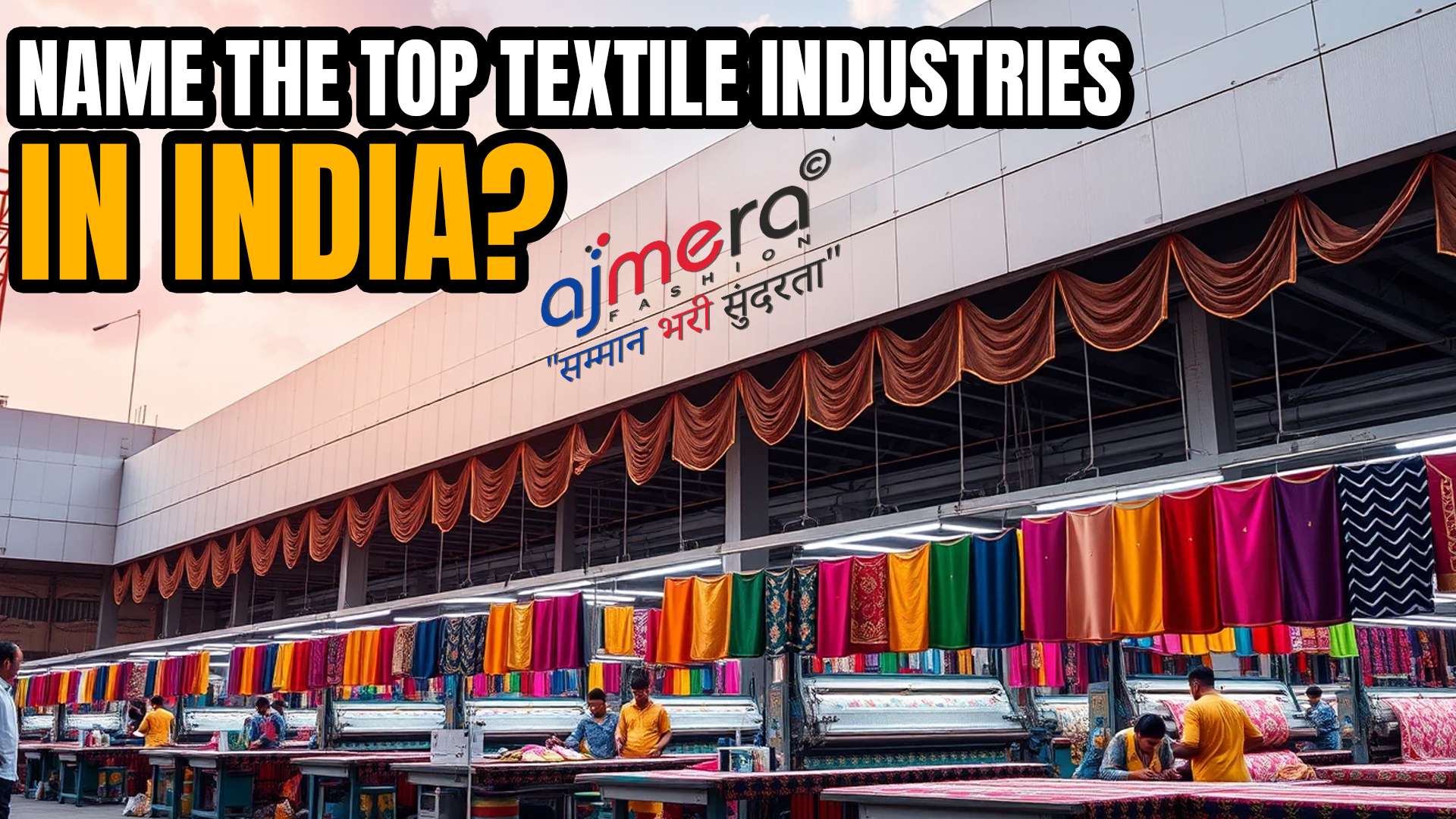Name The Top Textile Industries In India?

Share Blog:
A Glance Into The Best Textile Industries Of India
Ajmera Fashion knows that style is more than trends. It’s an amalgamation incorporating various elements like rich culture, skilled work, and many more. The Indian fashion label strives to promote and augment the amazing strides of the textile industries that are core to this fashion ecosystem.
India undoubtedly is among the first countries across the globe to have a history in textiles that was over a thousand years ago. Every state from Gujarat with its bandhani pret to Varanasi with its silk has a treasure of knowledge and experience woven into its fabric. Now, let’s go on a more detailed voyage of some of the most prominent textile industries of India whose unique skill is adorned all over the world.
1. Cotton: The Pride of India
Cotton from India has built a great reputation for itself on global platforms and it is well-deserved because of the comfort it provides. Also popularly known as Khadi – which is hand-spun fabric; cotton has become an integral cornerstone of India’s fashion identity. To add to the historical value, cotton has been referred to as “white gold” and holds great resonance with Mahatma Gandhi - as he constructed and popularized handwoven khadi cotton sarees for women, which quickly became a staple wardrobe piece.
-
Prominent Regions: Gujarat, Maharashtra, Tamil Nadu, Punjab, and Andhra Pradesh.
-
Did You Know: The largest producer of cotton in the world is India.

2. Silk: An Embodiment of Culture and Heritage Passed Down from Royals to Generations After
The legacy of silk weaving in India can be greatly traced back to several centuries and remains an industry that preserves culture to this very day. The Mughals embellished themselves with gold and silver threads, handwoven with ruthless detail by Indian craftsmen, that still exists to this day. Some notable mentions of silk garments include the silk Sarees of Kanchipuram in Tamil Nadu, decorated with intricate zari and Varanasi handwoven silk brocade. Examples such as this mark only a portion of India’s silk tradition.
-
Prominent Regions: Varanasi (Uttar Pradesh), Kanchipuram (Tamil Nadu), Mysore (Karnataka), Pochampally (Telangana).
-
Ajmera Fashion Connection: At Ajmera Fashion, we guarantee you that the old-age glory of silk is unparalleled. One can never say no to a beautiful silk Sarees, satin blouse, or a lehenga, and We know that the art of these regions underwent the utmost amount of hardship when making the silks.
3. Wool: The Mountain’s Warmth and Comfort
While India is home to summer temperatures, the northern hilly regions are rich with a history of wool production. Pashmina shawls made from Chinese changthangi goats with hair that came from Kashmir are famously warm and soft. Likewise, Himachal Pradesh woolen shawls and carpets are intricate designs and vibrant colors.
-
Key centers: Kashmir, Himachal Pradesh, Rajasthan.
4. Jute: The Golden Fiber
Also referred to as the ‘golden fiber, this plant belongs to the plant category’, jute is a renewable resource that can be used for various textiles. India is by far the largest country that produces jute and it is also used in many industries such as sacking and ropes among others last but not least, handloom fabric products and the region of West Bengal is well known for Jute sacking, as well as ornate Sarees and home textiles.
-
Key centers: West Bengal, Bihar, Assam, Odisha.
-
Ajmera Fashion Initiative: While focusing on being a socially concerned company, Ajmera Fashion also spreads awareness of sustainable practices. Currently, we are looking into ways of adding jute and other eco-friendly materials to our future collections.

For Franchisee Inquiry, Call: +9163521 77288
5. Handicrafts: The Regional Form of Art Wrapped Up in Various Handicrafts
India is a land bursting with several regional textile traditions besides the above-mentioned three major sectors. There is the bandhani tie-dye of Gujarat, phulkari embroidery from Punjab, the leheriya wave patterns from Rajasthan, and an astounding number of the like crafts by the locals. Apart from being aesthetically pleasing, such hand-made textiles serve as a physical connection to the country’s multifaceted cultural history.
-
Key centers: Across the country of India each region is unique in what it specializes in.
Ajmera Fashion Inspiration: These are some of the local traditions that we have geared our designs towards. Expect slight reminders of these rural crafts in the design so the characteristic of Indian textile mythology is not lost.
This insight into the top textile industries in India is just the tip of the iceberg as far as this field is concerned. India has a distinct fashion narrative as each region comes along with its own storytelling narrative, techniques, and fashion. At Ajmera Fashion we take great pride in procuring our fabrics from diverse locations across the country, thus ensuring that the designs are a true reflection of Indian textile art.
Look at the collection: We encourage you to visit our website (ajmerafashion.com) and browse through a colorful array of clothes and accessories that are centered around Indian textiles that showcase intricate attention to detail and skill in the Indian textile market. We appeal to you to delve into fashionable silhouettes that have been intricately designed with love and have been steeped in traditions.

For Wholsale Inquiry, Call: +916358907210
Also read: Why is Clothing Franchise Business Popular In India.
FAQs:
Q What makes Indian textiles stand out?
A-Indian textile treatments have a great history, their variety of techniques (weaving dyeing, and embroidery), making use of a wide array of natural fibers, and their simply brilliant colors. Every geographical location has its own disparate style and specialty.
Q Which Indian textiles are the most popular?
A- They include a few of them:
-
Silk: Banarasi, Kanjivaram, Mysore
-
Cotton: Khadi, Mulmul, Kalamkari
-
Wool: Pashmina, Kashmiri shawls
-
Others: Bandhani, Leheriya, Phulkari
Q Handloom textiles in India: what are they and what is their value?
A-They are hand-woven textiles, which are created by using basic tools and simple techniques, sustaining the cultural heritage and providing jobs to millions of artisans. These textiles have been regarded as more exclusive as compared to the machine-made varieties.
Q- What quality Should I look for to spot hand-loomed products?
A- Slight defects in the weave, selvage (the finished borders) work, and the use of natural fibers are some signs that may assist you. Where possible, purchase directly from weavers or approved cooperatives to guarantee authenticity.

For Franchisee Enquiry, Call: +9163521 77288
Also Read...
-
Business To Start With 2 Lakh Rupees Of Investment In India?
-
I Want To Start A Saree Business. Where Can I Get Sarees At Wholesale Prices?
-
Start a Home-Based Business with Ajmera Fashion – Low Investment, Premium Products
-
Who Is The Biggest Cotton Salwar Suit Manufacturer In India?
-
How do I start a textile manufacturing and export business in India?
-
Is it Possible to Start a Business with Little to No Money? How?
-
I want to buy a beautiful chiffon saree. Where can I buy it?





